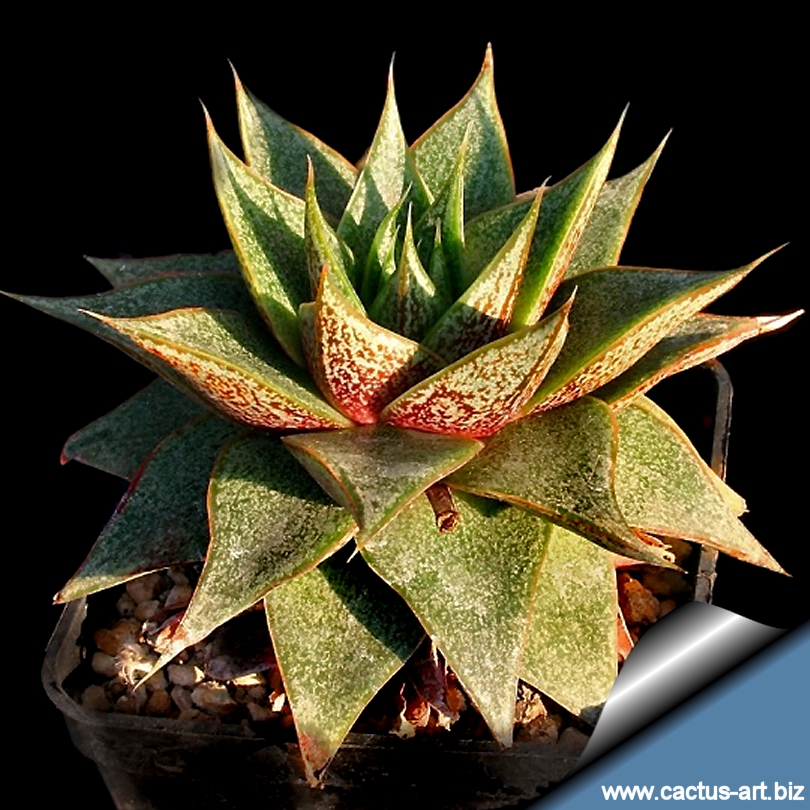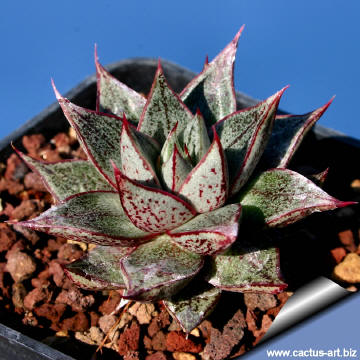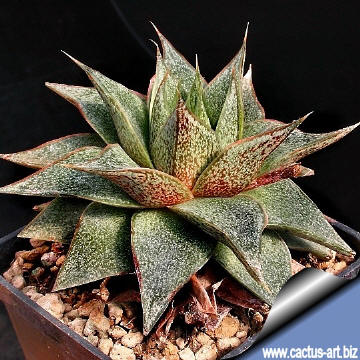|
|
|

Echeveria purpusorum
(usually known as an Urbinia)
is one of the
slowest-growing Echeverias and it is necessary to
cultivate it
for many years to get a nice specimen. Its attractiveness lies in the
beautifully speckled leaves.
|
|
Description: E. purpusorum
is a small slow growing and unusual species. It has
succulent
rosettessucculent rosettes, up to 6-8 cm in diameter and tall, it
stay usually
solitary but it can offset to form a dense clump.
Stem: Very short (almost stemless) it can slowly grow up to 5-7
cm tall, and approx 2 cm in diameter.
Leaves: Crowded, short, and turgid, ovate, acuminate, acute,
somewhat recurved at tips, 3-4 cm long and 1,5-2,5 cm wide, 1 cm thick,
flat above, rounded beneath, obscurely keeled on the back, deep
olive-green or spinach-green, marbled grey-green or white-green and
mottled with irregular small redish-brown spots. Margins sharp,
translucent, not mottled dark purple. The epidermis is unusually thick
with opaque epidermal cell and with few stomata in both leaf surfaces.
Flowers: On a 20 cm tall simply racemose inflorescence (cincinnus)
bearing in its basal portion few ovate and acute bracts up to 15 mm long
of the same colour of leaves. The 6 to 9 flowers buds are red-orange and
open to yellow. Pedicel up to 12 mm long, sepals appressed, calix
Globose-urceolate, up to 12 mm long,, greatest diameter 9 mm., about 4
mm. in diameter at mouth at anthesis; pink below, dark-orange to scarlet
above, yellow at the tips. The petals are thick, deeply hollowed within
at base, but scarcely keeled; nectaries large and thick, truncate-reniform,
2 mm. wide. Style apple-green, stigmas Hays-maroon.
Blooming season: Late spring (May-June).
Note: The plants that are found in
cultivation are quite uniform, probably owing to vegetative propagation
from a single original import. Any evident departures from the standard
form, may be suspected to be due to garden hybridization, whether
accidental or intentional. Numerous hybrids are now in cultivation.
|

Young specimen
|

Mature specimen
|

Long leaf form |

Short compact leaf form |
|
It is one of the most handsome and district of echeverias its unusual
foliage closely simulates that of some South African Haworthia of the
Liliaceae.


|
|
Advertising
|
|
|
|
|
Family: Crassulaceae
Scientific name:
Echeveria purpusorum A. Berger
In: Engler Nat. Pflanzenf, ed. 2, vol. 18a, p. 476,
1930.
Origin:
Southern Mexico, Puebla and Oaxaca (Type
locality Puebla: near San Luis Atolotitlan)
Habitat: Grows in quite hot and dry areas.
Common English Names include:
Etymology: The genus Echeveria is named after the 18th
century Spanish botanist Atanasio Echeverria Codoy.
The species purpusorum is named after the Purpus brothers,
Carl A. Purpus (1851-1941), German botanist and explorer
in mexico ans USA and Joseph A. Purpus (1860-1932), German
horticulturist. (this species was collected with both working together).
Synonyms:
- Urbinia purpusii Rose
In: Contrib. U.S. Nat. Herb., vol. 13, p. 302, 1911
- Echeveria Purpusii K. Schum
In: Gartenflora VL (1896) 608, fig. 97
- Dudleya Purpusii (K. Schum.)
Britt. et Rose.
|
|
|
|

Rarely
offsetting, it has greatly thickened,
drought-resisting
leaves with nice dark
edges and small red spots.
|
 Cultivation: it can tolerate sun
to shade but - generally speaking - the more light a plant gets the
better it will display its colours and shape. However, when moving plants from lower light conditions into full sun,
be wary of sun scorch, most easily avoided by ensuring plants are well-watered
before moving them on a cloudy day. They can tolerate
extended dry periods and survive drought without the need for watering,
but they will grow stronger if they receive adequate moisture during
their growing season, ut never allowing the plant to remain waterlogged
(root rot sensitive). Use a very porous soil, which will allow quick drainage. Slow
release fertilisers with a low to moderate nitrogen content are adequate for the spring and summer
growing seasons, and additional fertiliser applications
would not required until spring. Good air movement is
important for minimising pest and disease risks, and avoiding excessive
humidity in cool winter conditions is important to successfully growing
Echeveria in the nursery environment. It can tolerate light frosts, but
it is best overwintered at 5-10 °C.
With the cooler autumn temperatures tending to make their foliage
colours become more intense than those of the active summer growing
season.
Aphids like this plant (and all flowering Echeverias).
Propagation: Usually by
seeds, but If the plant is
repotted
some of the bottom leaves can be removed, in order to attempt
leaf propagation, it is also a common practice to
collect the leaves on the
flower stem.
However this is not one of the easiest
species
to root, as many such
cuttings will dry out
without producing a
plantlet, but with perseverance it is likely to get
a few new plants. Needs good
drainage |
|